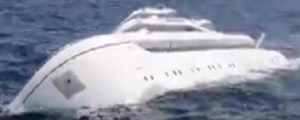The Charity
Aviation
Maritime
M2136

Initial Report
Two additional decks had recently been added to a large liveaboard diving vessel which was subsequently chartered by a diving group for a trip to do both wreck and reef dives.
Early in the voyage, members of the dive group noticed that the vessel had a consistent list to port of approximately 2 to 3 degrees. They raised this with the crew, who assured the divers that this was most likely due to the unbalanced filling of the freshwater tanks for the voyage.
The vessel departed in the morning, and group completed two guided dives before the vessel went to anchor overnight. It was a calm night, but the group noticed that the list had increased to 4-5 degrees. Again, the crew reassured the group that all was well.
At first light, the vessel got underway and set off to another dive site – this time with a list of 5-6 degrees. As it approached the main shipping lane at 10 knots, the vessel heeled over to starboard and over the next hour the list progressively worsened until it capsized onto its side in less than 30 seconds. One of the vessel’s life rafts was released but did not inflate as the painter was not secured to the vessel. It was later manually inflated but could not be righted. The 2nd life raft was released and inflated, and the vessel’s tender boat, despite being slightly damaged, was used to tender passengers and crew to the life raft. Flares were released, and other nearby dive vessels came to assist. The dive team on board carried out dangerous and courageous rescues within the vessel to free trapped passengers and crew.
All passengers and crew (35) were eventually accounted for and taken back to port, where further assistance from the navy was provided to the traumatised survivors. According to our reporters, escape from the vessel was hampered by missing handles on one of the emergency escape hatches, and missing handrails on the stairs between decks made it extremely difficult to get out of the vessel. The lack of securely fastened furniture, including unsecured beds, also created a hazardous environment with floating debris obstructing escape routes. None of the passengers received a safety briefing upon boarding the vessel.
CHIRP Comment
Significant structural changes invariably affect stability, and inclining tests must be conducted to update the vessel’s stability curve data. Despite the passengers raising concerns on several occasions, it is troubling that the crew neither recognised nor reacted to the obvious warning signs. At best, this indicates a lack of training and at worst, the company put commercial interest above crew and passenger safety by continuing the voyage. Although the vessel had significant safety design defects e.g., lack of handrails on the steps between decks, the crew also demonstrated a complacent attitude to safety: items were not correctly secured for sea, nor were basic safety items such as the life raft painter correctly fitted. These, and the lack of a safety briefing for the guests, all point to a poor safety culture compounded by inadequate crew training and competency,
The successful rescue of all passengers and crew is a testament to the diving guests’ exceptional bravery and quick thinking. CHIRP has maintained contact with the dive team following the traumatic rescue. Many of them, including the passengers, are now receiving trauma counselling therapy.
Key Issues relating to this report
Design – Poor design choices when installing the additional decks significantly affected the vessel’s stability. Scrutiny of the stability requirements should have occurred before the refit; and after the work had been completed, it should have undergone an Inclining test overseen by the Class society and Flag.
Pressure – Commercial pressure to return the vessel to service meant that stability tests and sea-trials were not conducted. And once it had begun its fee-earning voyage, passengers’ concerns were ignored, which ultimately led to the vessel’s capsizing and endangering the lives of all passengers and crew. Commercial considerations must never be at the expense of safety. If you are a crew member joining (or on) a vessel that has had substantial structural change, ask to see evidence that stability tests and sea trials were correctly carried out.
Situational awareness – The crew did not recognise that the unexpected list was a sign of potentially inadequate stability, nor did they react when this got worse during the voyage. This is most likely due to insufficient training.
Culture – The operating company and the owners lacked care for the passengers and crew, as reported to CHIRP. They were not offered any counselling following their traumatic ordeal and had little in the way of any compensation despite losing all their equipment and possessions. Their lives were only saved because of their professionalism as divers.
This data type is not supported! Please contact the author for help.






